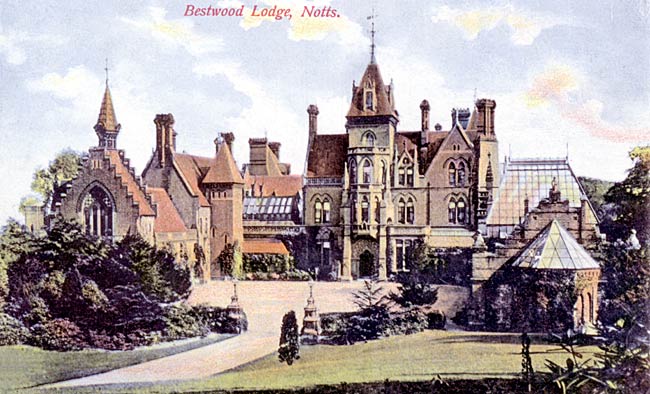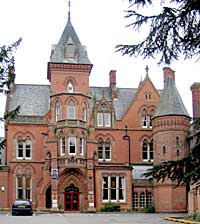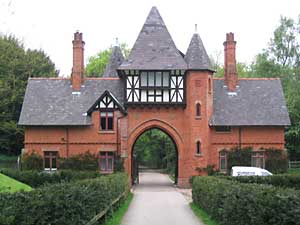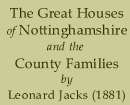< Babworth | Contents | Bramcote >
Bestwood Lodge

Bestwood Lodge, c.1905.
A PERSON straying from the high road to Mansfield at a point beyond the village of Daybrook might by accident find himself in one of the paths intersecting a thickly wooded plantation of youthful firs both of the Scotch, Corsican, and Australian varieties, which have approached as near to Bestwood Lodge as they well can do without violating the laws of consistency. It is just possible that such a person pursuing the sinuous pathway, if he happened to wander here during certain periods of the year, might chance to come upon a gentleman, attired in a suit of grey, somewhat determinedly engaged with a long-shafted instrument, in putting an end to the existence of occasional thistles and other noxious weeds which cumber the soil. Such an apparition would scarcely alarm him ; there would be nothing extraordinary in such a spectacle. But if the wanderer were suddenly told that the solitary gardener, the thoughtful looking, trim bearded, grey suited gentleman, was the Hereditary Registrar of the Court of Chancery, the Hereditary Grand Falconer of England, was in short his Grace the Duke of St. Albans, he would in all probability feel somewhat surprised and certainly he might reasonably come to the conclusion that he had lost his way. To us, who know very little of the home life of the highest in the land the spectacle of a noble duke hoeing thistles and thinning his own plantations, seems very strange. But it is well known that many of those who belong to the aristocracy of birth, and to the aristocracy of genius employ their leisure time in the simplest ways. A late territorial magnate possessing half a dozen titles has a great fancy for being amongst his workmen ; the late Sir Robert Peel was fond of rolling his own grassplot; Mr. Gladstone found recreation in felling big trees, and other distinguished men, when at home spend much of their time in the simplest pursuits. The Duke of St. Albans, during his residence at Bestwood, which is never of long duration, spends very little time indoors. He has the most charming study or private room, containing a small collection of good solid literature, but you won’t find him there when the weather is anything like fine. It is a room of fairly large proportions and though readily accessible from all the other principal rooms on the ground floor, it is always perfectly still and you cannot hear a sound of what is going on outside its walls. Its panneled ceiling would give it a sombre look were it not for the abundant light let in through a tall handsome window against which the stirred leaves of a creeping plant flutter. His Grace when he is writing can almost see what is going on in Nottingham. The outlook is right across the ducal park and cricket ground to Nottingham. It is a prettily furnished cosy room, full of various articles de luxe. The walls are not overloaded with pictures, but they contain perhaps the most prized works in his grace’s collection. Here is a recent portrait of the present Duchess from the brush of one of the most distinguished modern artists, representing her grace in a simple black high dress, relieved by just one scarlet flower fastened at the throat. There is here a portrait of the late duke, a large painting of Redbourne,—his grace’s Lincolnshire seat, in which are the figures of two ladies in a small pony carriage who are holding converse with a substantial ecclesiastic of the old school, just dismounted from a stout cob. In the background is Redbourne Church, half concealed by autumnal foliage. Over a handsome barometer clock, which occupies a goodly portion of the mantelpiece, is an elaborately-carved frame containing a portrait of some Spanish beauty ; the eyes are dark and soft, and the complexion is delicate olive. His Grace is always bringing home something beautiful from abroad, and that long table against the wall is covered with all kinds of little nick-knacks. Some of these have come from far distant climes. Here too are some few family treasures, including a small illumination painted by the late duchess, and containing a vignette of her whose memory still lives, and the likenesses of some of her relatives. The bright coil of golden hair of such silky texture, carefully preserved under glass and set in an oval frame of dark blue velvet, on which is inscribed in golden letters, the word "Cuckoo," was once worn by the duke’s eldest daughter, Lady Louisa Beauclerk.

Main entrance to Bestwood Lodge. Pevsner regards the building to be one of the best examples in the county of "the High Victorian mansion on a lavish scale but of medium size". It was built for the tenth Duke of St Albans in 1862-5 by S S Teulon.(Photo: A Nicholson, 2004).
Bestwood Lodge is in all respects a fit residence for a nobleman of the highest rank, and its historical associations are most interesting. History relates that Bestwood was once a Royal residence, much used for hunting purposes. King Edward III. issued certain letters patent, dated, "at his Park at Bestwood," in 1364, and earlier still, Henry I. granted to the Priory of Lenton permission to have "two carts to fetch dead wood and heath out of Bestwood." Henry II., about the year 1160, granted the convent to have every day "two carts, or carrettes, to bring them dead wood or heath, as much as they should need for their own use." From the same source we learn that in 1329, Bestwood was granted by Edward III. to Richard de Strelley for his life. This monarch on the 22nd of February, 1535, also granted to Richard de Strelley "all the dry bruches, which in English were then called slovens or stubbs, within the Hay of Bestwood." Bestwood has long been the seat of nobility. It has been in the hands of three Earls of Rutland before then a celebrated courtier in the reign of Elizabeth, Thomas Markham, by name, had it, and earlier still it was the residence of Sir John Byron, one of Henry the Eighth’s favourites. In 1683, the Second Charles, by royal letters patent, granted the park at Bestwood to Henry Beauclerk, Duke of St. Albans, and it has since that date remained in the hands of the Beauclerks, who have at various times united themselves with some of the oldest houses in England. The first duke for instance married the sole heiress of the last Earl of Oxford. The eighth duke married the heiress of Mr. Carter Thelwall, of Redbourne Hall, and subsequently the heiress of Mr. John Nelthorpe, of Little Grimsby Hall, which marriage accounts for the acquisition of the 5,000 acres owned by the Beauclerks in Lincolnshire. The situation of the present mansion, which was completed but a very few years ago, is one of the finest in the county, so far as elevation is concerned, and though only about four miles from a large manufacturing town it occupies a perfectly retired position, and its privacy is as securely maintained as though it stood twenty miles from any seat of industry. Standing on its broad terrace when the lights are lit at Nottingham you might almost fancy that the town was only a stone’s throw from that high eminence. It is built in the domestic style of architecture which distinguished the fourteenth century, from the designs of a celebrated London architect, Mr. S. S. Teulon, and it forms a very handsome and conspicuous object from many points. The flower beds in front of the terrace are arranged in a kind of semi-circle, and below is a lawn of exquisite softness sloping down to the edge of the park. There are some large trees in the neighbourhood of the lawn-tennis ground, and these are allowed to grow as they will. They are really the only few old trees on the estate, and His grace likes to see their tall leafy forms. The duke is a great admirer of trees; firs are his special favourites, and he himself has introduced a fine variety from Corsica which mingle well with their sturdy brethren of Scotch extraction. The large plantations which occupy a considerable portion of the estate, are composed almost exclusively of firs which when they reach maturity will form a fine forest. A large strip of the kitchen garden is devoted to the development of the young trees which are perpetually being transplanted for the enlargement of the covers. His Grace is a great lover of unconventional nature, and he is the careful protector of woody vegetation. He will not have his trees and shrubs trimmed and lopped. The few gorse bushes which are left to indicate the remote existence of forest land, he preserves inviolate, and laurel, bay, blackberry, and gorse grow up together on the Bestwood domain.

Gatehouse of Bestwood Lodge (Photo: A Nicholson, 2004).
The laws of comfort and convenience have been carefully studied in the internal arrangement of Bestwood Lodge, and the furniture and fittings of the fine large rooms bespeak the owner to be a man of refined and cultivated taste. To the central ball light is admitted through a lofty glass dome, and the roof is large, massive, and ornamental. It is luxuriantly furnished, and probably its best aspect is seen from the gallery, which is arranged midway between the roof and the floor. There are some family portraits here, one a life size picture representing the duke’s three daughters ; the two girls Lady Louise and Lady Sybil are paying attention to a Muscovy duck which has come from the pond on the lawn to be fed, and the boy—Lord Burford is amusing himself with a wooden horse. There is a handsome portrait, painted some time ago I should imagine, of the duke in the green and embroidered dress of grand falconer, and one of the late duchess. There are paintings here of the sixth and eighth dukes, and to the decoration of the room has recently been added a pair of far-spreading antlers, which probably at some remote time belonging to a very fine specimen of the Irish elk—now extinct. The central hall is full of beautiful things nod it makes a delightful sitting-room. All the other principal rooms seem to radiate from this hall, and the arrangement is a very convenient one. The drawing-room at Bestwood has an outlook from lofty curtained windows which embraces all the quarters. The pictures here are chiefly portraits of kings and nobles, many of them from the brush of Sir Peter Lely, who painted Charles the First, Charles the Second, and Cromwell. I have sometimes thought I should like to see Lely’s portrait of the Protector, in which the painter, in obedience to instructions, represented with perfect accuracy every pimple on that august person’s somewhat bibulous countenance. It is not at Bestwood, but this master’s portrait of Charles the Second hangs on these walls. Several of the best pictures from this and other rooms were at the time of my visit at the Castle Museum, his Grace having generously allowed the authorities of that institution to make a tolerably copious selection from his walls. There is a good deal of Lely’s work at Bestwood. Lely’s portraits of women are perhaps unrivalled ; there is a dignity about them which marks them as persons of high rank. There is one here of the notorious Barbara Villiers, Duchess of Cleveland, and another of Elizabeth Noel, Countess of Berkeley, from the brush of this master. There is a beautiful picture in the drawing-room of a recumbent female figure remarkable for the brilliancy of its colouring and for a certain charm of flesh-painting which at once strikes the eye. The general look of the features closely resembles that of a portrait of the beautiful Nell Gwyn which is hung in another part of the house. There are also in this superb drawing-room a couple of portraits of Charles Beauclerk, first Duke of St. Albans, one of them painted when the subject was a child, by Gascar, the French artist, to whom sat James II. when Duke of York ; a portrait of Charles I. in armour, by Jamesone; a small portrait of the seventeenth Earl of Oxford portraits of Diana do Vere, Duchess of St. Albans, daughter of the twentieth and last Earl of Oxford ; of Lord Aubrey Beauclerk, who was killed at Carthagena ; of Lord Amelius Beauclerk, a distinguished naval officer, the only ancestor of the Duke’s who ever made Bcstwood his home ; and of the first Earl of Berkely. In one of the window recesses I noticed three little gems which are worthy, and perhaps have by this time, a more prominent position. The centre one is a tiny landscape by the youngcr Teniers—a moonlight scene, "touched with a spirit," and displaying that silvery charm with which this great painter invested all his best known landscapes. Of the others, one is a Fragonard, and the other a good specimen of Rottenhamer’s delicate colouring. The mantel-pieces in this room, as in the dining-room, are of marble, inlaid with mosaic work, executed by Italian artists, and near one of them stand a couple of crayon drawings, one of Lady Diana Huddleston, which at one time graced the state cabin of his Grace’s yacht, but which now makes one of a pair of pretty screens. There arc all sorts of beautiful things in the drawing-room. There are cabinets of ornamental china, and wondrous little china ornaments, chiefly figures of foreign make, most of them brought from Spain. In one of these cabinets may be seen placed upon a handsome mount, a small wooden doll, which at some early period of its existence has gone through a course of harsh treatment, for its limbs are imperfect and charred, as though it had accidcntally fallen into the fire. The mount is inscribed as follows:—"This doll was worn by Albert Edward Prince of Wales on his return from seeing the Derby run in 1865. And there was much ado about nothing in consequence." The dining-room is of fairly large proportions, and perhaps it is the pannelled ceiling of darkly stained wood which gives it a somewhat darkened aspect. There is here a bust by Roubiliac, of Wilks, the founder of the Beef Steak Club, and an oval Magdelene over the mantel piece, which almost reminds one of some of Lely’s efforts. The billiard-room, the foundation stone of which was laid by Earl Cadogan, who was at Eton with the noble duke, is just what a billiard-room should be. It is lofty, cheerful, and perfectly ventilated, containing some half-dozen pictures, including one of her Majesty’s ship Dryad, of 36 guns, captured by Lord Amelius Beauclerk, and bringing to close action the French frigate Proserpine ; some oriental figures which his Grace has brought from abroad, and other appropriate articles of decoration. All these rooms, die drawing-room, the dining—room, the billiard—room, and the study are closely associated with each other. They are all on one basement, and the means of communication between one and the other is admirably arranged. The conservatory is connected with the house, and without walking ten yards you find yourself under a spacious glass roof enclosing palms and trees of luxuriant growth, with creepers bearing deep purple flowers ; the banana tree of Abysinnia, and the beautiful feathery papyrus which grows more luxuriantly here than I have ever observed it grow elsewhere. At the extreme end of the conservatory is a sort of rockery arranged in a form of an alcove in which is placed a beautiful white marble statue of "the two sisters." The expression on the young faces is exquisitely sweet, and the limbs are gracefully and delicately rounded. The arrangement of the up-stair rooms, to reach which you have to pass a large oblong picture representing Charles with his retinue going from the tower to Whitehall is as happy as that downstairs. One of these is the boudoir of the accomplished duchess—the daughter of Mr. Bernal Osborne. The walls are fairly covered with some choice water-colours, chiefly small landscapes, and the carpet of the softest fibre is of dark blue, dotted with designs of a paler hue. His grace has had some of the pictures hung in a somewhat novel manner; four or five of the smaller ones are fastened together in the form of a cross. Distributed through these upper rooms are several excellent little paintings from the brush of her grace’s sister, Mrs. Blake, who is not an unfrequent visitor at Bestwood.
The little church at Bestwood is associated with the memory of the late duchess, for the massive tombstone of solid granite, surrounded by a narrow bed of flowers, at the west end marks her resting place, and the two beautiful little stained windows and the marble medallion, carved by Royal hands, serve to put one in mind of her who was loved so well. The altar cloth, embroidered with genuine artistic taste, is the work of a "vanished hand," and the cloth covering the kneeling place at the Communion Table, is another specimen of the late duchess’ pious industry. It is a very pretty church with an apsidal end, and when the duke and his family are at Bestwood they regularly attend the services.
Princes have been entertained at Bestwood, twice within a period of four years. In 1878 the duke opened his house to the Prince and Princess of Wales when H.R.H. opened the Castle Museum, and in 1881 he entertained the Duke of Albany and a large and distinguished party on the occasion of the opening of the University Buildings. In 1878, the Prince and Princess of Wales, being desirous to leave some memorial of their visit, each planted a tree, which is carefully guarded from harm, near the entrance to the hall. The Duke of St. Albans spends but a very small portion of his time at his charming Nottingham seat. He is very fond of yachting, and he feels healthy breezes when sailing on the blue waters of the Mediterranean. During session he attends assiduously to his Parliamentary duties, and he sometimes rises in his place in the house of Lords to put important questions to the representatives of the Government in the upper chamber. Nor does he always confine himself to putting questions. On one occasion he answered a somewhat taunting question put to him by the Duke of Richmond, in a manner which must have surprised the then lender of the Conservative party in the Lords, and the house generally. The duke takes an active interest in what concerns the welfare of Nottingham. In her educational, and even in her political organisations—the duke is a Liberal in politics—he takes an interest, and he is always ready to lend his assistance to every good movement. In private life the Duke of St. Albans is no less respected and esteemed than in public. His manners are affable and pleasant to a degree, and whether at a race meeting, a cricket match, or at a social gathering, his geniality and easy courtesy win the esteem of those with whom he comes in contact.
